Shunyata Research ALTAIRA Chassis Ground Hub by Don Shaulis
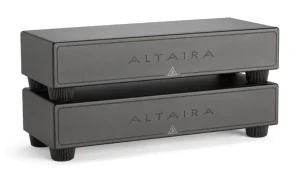
Grounding: An Essential Ingredient
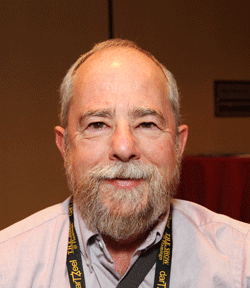 Chassis grounding has been around for decades. It originated in the telecommunications industry, where multiple pieces of equipment share a metal rack, and grounding is essential. Home audio systems tend to be on wood racks or platforms, so electrical grounding has only recently become more mainstream. Several companies offer audio grounding systems. While the science behind the offerings has been vague and confusing, the proof is in the listening. Reports of demonstrations of the Shunyata ALTAIRA chassis and signal grounding hubs were all very positive and piqued my curiosity.
Chassis grounding has been around for decades. It originated in the telecommunications industry, where multiple pieces of equipment share a metal rack, and grounding is essential. Home audio systems tend to be on wood racks or platforms, so electrical grounding has only recently become more mainstream. Several companies offer audio grounding systems. While the science behind the offerings has been vague and confusing, the proof is in the listening. Reports of demonstrations of the Shunyata ALTAIRA chassis and signal grounding hubs were all very positive and piqued my curiosity.
 After acquiring Sound Lab speakers (Review here), I replaced almost everything in my system. In fact, I need help remembering what equipment predates the Sound Labs. They are a demanding mistress. I am pleased with my current system but, like many audiophiles, I am willing to be happier. After my components and cables reached a certain level, it became increasingly difficult and expensive to make a step up. Some of my components and cables are the flagship of their brand or one step below. Swapping a single cable or power cord seldom proved informative, and replacing a loom was cost-prohibitive. And changing one brand for another was no guarantee of increased happiness. I started looking at other options. I have used Shunyata products for decades and was currently using a Shunyata Typhon T2 and Denali 6000/S v2 power conditioner stack. It was only logical to try a Shunyata grounding system. My glass-half-full attitude considered that an opportunity to upgrade multiple components simultaneously.
After acquiring Sound Lab speakers (Review here), I replaced almost everything in my system. In fact, I need help remembering what equipment predates the Sound Labs. They are a demanding mistress. I am pleased with my current system but, like many audiophiles, I am willing to be happier. After my components and cables reached a certain level, it became increasingly difficult and expensive to make a step up. Some of my components and cables are the flagship of their brand or one step below. Swapping a single cable or power cord seldom proved informative, and replacing a loom was cost-prohibitive. And changing one brand for another was no guarantee of increased happiness. I started looking at other options. I have used Shunyata products for decades and was currently using a Shunyata Typhon T2 and Denali 6000/S v2 power conditioner stack. It was only logical to try a Shunyata grounding system. My glass-half-full attitude considered that an opportunity to upgrade multiple components simultaneously.
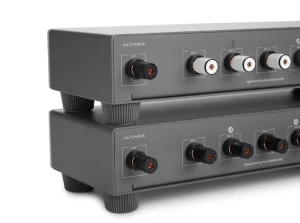
Technology:
 ALTAIRA is a centralized grounding system that eliminates inter-component ground loops to reduce ground-plane noise. That is the noise you are not aware of until it is gone. Then your ears perk up, and you realize the improvement. Shunyata makes two models of grounding hubs, each designed to optimize specific noise frequencies and origins. The ALTAIRA Chassis ground hub (CG-NR) is tuned specifically to chassis-borne noise. The ALTAIRA Signal ground hub (SG-NR) reduces internally generated component-borne noise riding on signal grounds.
ALTAIRA is a centralized grounding system that eliminates inter-component ground loops to reduce ground-plane noise. That is the noise you are not aware of until it is gone. Then your ears perk up, and you realize the improvement. Shunyata makes two models of grounding hubs, each designed to optimize specific noise frequencies and origins. The ALTAIRA Chassis ground hub (CG-NR) is tuned specifically to chassis-borne noise. The ALTAIRA Signal ground hub (SG-NR) reduces internally generated component-borne noise riding on signal grounds.
Shunyata recommends the chassis hub as the starting point for simple systems. My system is relatively simple but more challenging because it is split on two walls. I opted for one chassis hub with plans to try it on my speakers and amplifiers before adding it to the Denali/Typhon stack supplying my source components.
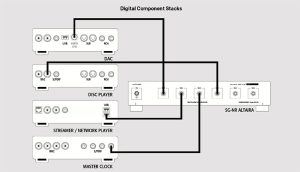
The ALTAIRA chassis hub has six terminals for connecting components. Each terminal will accept a spade and banana connector simultaneously. There is also a hole to accept bare wire. A seventh terminal is used to connect to an earth ground. The filters in each dedicated zone of isolation are tuned to the frequencies most commonly found riding the chassis grounds, often contaminated with electromagnetic interference, including radio, television, microwave, WiFi, and cell tower frequencies. The signal hub works similarly but is tuned to different frequencies, especially noise generated by the equipment.
 Shunyata makes grounding cables at multiple levels and at different costs. They are constructed to have the least impedance possible at their price points. Reduced impedance increases performance. Terminations are spades or bananas. Shunyata also makes ground tail adapters (clock (BNC), Ethernet, RCA (S/PDIF), XLR, USB-A, and USB-B) for signal grounding or to use for chassis grounding if no convenient ground screw is available. There are no separate grounding cables for chassis or signal grounding. What is grounded is determined by the ALTAIRA hub model to which the cables are connected. So a ground tail adapter can be used to ground a chassis using any of the configurations offered because the adapters only connect the ground leg and do not make a complete signal connection. The ground tail adapters fit on the banana end of a grounding cable and can easily be swapped out as equipment changes require. Cables are not directional, which increases their versatility. The user can have a cable with a spade on one end and a banana termination on the other and reverse the installation direction whenever needed.
Shunyata makes grounding cables at multiple levels and at different costs. They are constructed to have the least impedance possible at their price points. Reduced impedance increases performance. Terminations are spades or bananas. Shunyata also makes ground tail adapters (clock (BNC), Ethernet, RCA (S/PDIF), XLR, USB-A, and USB-B) for signal grounding or to use for chassis grounding if no convenient ground screw is available. There are no separate grounding cables for chassis or signal grounding. What is grounded is determined by the ALTAIRA hub model to which the cables are connected. So a ground tail adapter can be used to ground a chassis using any of the configurations offered because the adapters only connect the ground leg and do not make a complete signal connection. The ground tail adapters fit on the banana end of a grounding cable and can easily be swapped out as equipment changes require. Cables are not directional, which increases their versatility. The user can have a cable with a spade on one end and a banana termination on the other and reverse the installation direction whenever needed.
Shunyata notes an ALTAIRA does not require an earth-ground to be effective but does perform better if an earth-ground is supplied. That is typically accomplished by connecting the 7th terminal on the ALTAIRA to the grounding terminal on a Shunyata power conditioner. If no power conditioner ground terminal is available, Shunyata makes an AC socket ground adapter that connects to an A/C wall socket ground wire. The AC adapter uses a standard ground wire with a banana termination.
For better performance or more complex systems, Shunyata recommends using multiple chassis hubs and segregating digital components from analog components. Surprisingly, I noted that Shunyata considers DAC analog components while CD players are digital components for segmented grounding purposes.
Connecting an ALTAIRA Chassis Hub:
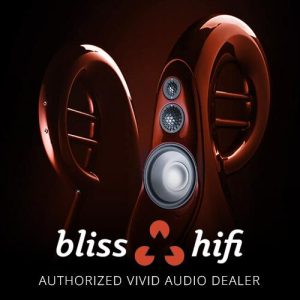 If a component has a grounding terminal, connecting to an ALTAIRA hub is easy. If there is no grounding terminal, a good option is to use a spade underneath a chassis screw that has continuity to the component’s electrical ground. Use an Ohm meter to measure the continuity between the screw and the IEC inlet ground pin. A measurement of less than 1 Ohm is desired.
If a component has a grounding terminal, connecting to an ALTAIRA hub is easy. If there is no grounding terminal, a good option is to use a spade underneath a chassis screw that has continuity to the component’s electrical ground. Use an Ohm meter to measure the continuity between the screw and the IEC inlet ground pin. A measurement of less than 1 Ohm is desired.
Shunyata ground tail adapters provide a third method for chassis grounding. Often, a signal connector has a direct electrical connection to the component’s chassis. Continuity between an unused signal connector’s ground pin or barrel and the IEC ground pin should be verified with an ohm meter. A reading of less than 1 Ohm means you can use the connector for chassis grounding. Remember, there is no difference in the cables. The difference is in which ALTAIRA hub is used. Shunyata has a Component Continuity Test Worksheet, User’s Guide, and other information online. I recommend reading the documents to gain a more complete understanding. The process sounds more complicated than it is. Once the principle is understood, everything becomes easy. My primary goal here is to comment on performance.
I sometimes found it challenging to find a chassis screw large enough to hold a spade. Many manufacturers have gone to small, recessed screws for aesthetic reasons or to discourage exploration of internal components. Coated chassis do not make an adequate ground but screws penetrating the chassis do. My VAC Essence 80 iQ monoblocs (reviewed here) are an early production model without RCA inputs, so I was not able to use a ground tail adapter. For each amplifier, I mounted a copper spade-to-banana adapter to a bottom chassis screw. I drilled out the adapters so I could place the screw through the hole to make better contact and prevent them from coming loose when pulling out the grounding cables during seasonal amplifier swaps. While I had the Essence 80s on the operating table, I replaced the stock footers with Finite Elemente Slimline isolation footers. The large backplate screws on my Sound Labs provided an excellent connection place for spades. My Aurender N20 and VAC Master preamplifier both have grounding posts. I used an RCA ground tail adapter on my Bricasti M21 DAC.
Listen Up:
 My system is split on two walls in a dedicated room with a single 20-amp circuit. Having my system on two walls was a great move forward for performance but costly in terms of cables and power conditioning. I purchased the ALTAIRA for my source components because I know if something is lost or damaged up front, it cannot be recovered or repaired. But enquiring minds need to know. I was extremely curious to know how Sound Labs would respond to chassis grounding, so I started with the ALTAIRA temporarily on a platform between the speakers, where only the speakers were grounded. The improvement there was small but noticeable and a prelude to what was to come. The experiment was compromised and did not yield maximum results because I used long lengths of old speaker cables for grounding. Next I added my VAC monoblocs. Further improvement was made in the same direction. This was the theme I experienced as I moved the ALTAIRA to my source equipment wall. All changes were positive; only the amount changed. The improvements were more dramatic when I moved the ALTAIRA to the source wall. My comments below on performance pertain only to treating the source components. The improvements would have been even more significant if I could have connected my speakers and amplifiers to a single chassis hub. I could have connected all my equipment and only needed to double up on one terminal.
My system is split on two walls in a dedicated room with a single 20-amp circuit. Having my system on two walls was a great move forward for performance but costly in terms of cables and power conditioning. I purchased the ALTAIRA for my source components because I know if something is lost or damaged up front, it cannot be recovered or repaired. But enquiring minds need to know. I was extremely curious to know how Sound Labs would respond to chassis grounding, so I started with the ALTAIRA temporarily on a platform between the speakers, where only the speakers were grounded. The improvement there was small but noticeable and a prelude to what was to come. The experiment was compromised and did not yield maximum results because I used long lengths of old speaker cables for grounding. Next I added my VAC monoblocs. Further improvement was made in the same direction. This was the theme I experienced as I moved the ALTAIRA to my source equipment wall. All changes were positive; only the amount changed. The improvements were more dramatic when I moved the ALTAIRA to the source wall. My comments below on performance pertain only to treating the source components. The improvements would have been even more significant if I could have connected my speakers and amplifiers to a single chassis hub. I could have connected all my equipment and only needed to double up on one terminal.
 Emmylou Harris and Linda Ronstadt are two of the finest female vocalists of my generation. I regret that their producers and engineers did not treat their recordings respectfully and attentively. That criticism aside, Emmylou and Linda teamed up for some great duos on the album Western Wall: The Tucson Sessions [Asylum Records 62408-2]. Listening to the title track from that album with the ALTAIRA provided a cleaner sound with less glare. That resulted in more definition and extension on the guitar notes. But the magic for me in that track is the voices. With the ALTAIRA, the duet between Emmylou and Linda became smoother and more revealing of the differences in their voices. The two singers became more distinct.
Emmylou Harris and Linda Ronstadt are two of the finest female vocalists of my generation. I regret that their producers and engineers did not treat their recordings respectfully and attentively. That criticism aside, Emmylou and Linda teamed up for some great duos on the album Western Wall: The Tucson Sessions [Asylum Records 62408-2]. Listening to the title track from that album with the ALTAIRA provided a cleaner sound with less glare. That resulted in more definition and extension on the guitar notes. But the magic for me in that track is the voices. With the ALTAIRA, the duet between Emmylou and Linda became smoother and more revealing of the differences in their voices. The two singers became more distinct.
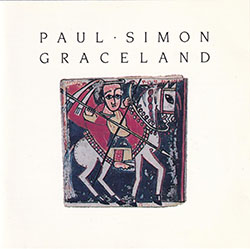 On Paul Simon’s CD Graceland [Warner Bros. R2 78904], the tracks “Homeless” and “Diamonds on the Soles of Her Shoes” with Ladysmith Black Mambazo shone with more clarity and visceral impact. Drums were especially improved and tighter on “Diamonds on the Soles of Her Shoes.”
On Paul Simon’s CD Graceland [Warner Bros. R2 78904], the tracks “Homeless” and “Diamonds on the Soles of Her Shoes” with Ladysmith Black Mambazo shone with more clarity and visceral impact. Drums were especially improved and tighter on “Diamonds on the Soles of Her Shoes.”
I explored other musical selections with ALTAIRA connected and not connected. The overarching result was a quieter background and a sharpening of focus, revealing details farther into the music. Musical instruments had extended harmonics. When the final word in a line was meant to fade out, the fade was more prominent and extended. Instruments and vocalists shrank in size just a little as the noise “halo” around them was stripped away. As with any already good system, improvements were incremental, not transformational. What I got was more of “why” I listen to music. The purity and detail were more engaging and less fatiguing. Nuances became more pronounced. I wanted to repeat my favorite tracks. All changes were positive. This is in contrast to equipment or wire swaps that sometimes improve one thing at the expense of another. ALTAIRA chassis grounding won’t magically fix source or component deficiencies but will improve most connected equipment’s performance.
Conclusion:
I had read comments that using grounding was icing on the cake. After using the ALTAIRA chassis ground hub I want to shout, “full stop!” Back up. Back all the way up. ALTAIRA chassis grounding is not icing on the cake. It is an essential ingredient. If you consider mechanical isolation critical to optimum performance and would never consider installing a component without it, treat grounding with at least the same reverence. For some equipment, electrical isolation may be more beneficial than mechanical isolation. If your room acoustics have been sufficiently treated and you can notice subtle but critical nuances, your system is a candidate for grounding. If you do not have grounding, then whatever the price level of your components is, you will not hear everything they have to offer. I understand the hesitation. If you own a $7,000 line stage, you are lusting after a $10,000 line stage. I have been there. But now I realize the addition of an ALTAIRA to my system upgraded every component connected to it. All the equipment that had previously passed through my system had not been heard at its optimum. The ALTAIRA chassis grounding system is now an essential part of my system. I would not want to be without it.


Specifications:
Price: Chassis Ground Hub: $2998
Price: Price: Ground Tail Adapters: $200 (RCA, XLR/F, XLR/M, BNC, Ethernet, S/PDIF, USB/A, USB/B)
Price: ALPHA-X Series, Grounding Cable 1M ($400) (other models and lengths are different prices)
Width: 14.1 inches (35.814 cm)
Total Depth: 6.9 inches (17.526 cm), faceplate to end of ground terminals
Depth: 5.6 inches (14.224 cm), faceplate to back of chassis
Height: 3.4 inches (8.636 cm) chassis with feet
Weight: 8.2 lbs (3.7 kg)
Number of Ports/Isolation Zones: 6
Noise Reduction: 6-12dB @ 3kHz-30MHz
Power Requirements: None
Construction: Aluminum and steel chassis and machined aluminum faceplate
Vibration Control: Isolation polymer footer
Contact:
Website: https://shunyata.com/
Email: info@shunyata.com
Telephone:360-598-9935
Address:26273 Twelve Trees Ln NW
Poulsbo, Washington 98370
Don’s Associated Equipment
Source Component Wall:
Shunyata Typhon T2 with umbilical cord
Shunyata DENALI 6000/S v2 power conditioner
Shunyata ALTAIRA chassis hub (CG-NR)
Shunyata SIGMA XC power cord
Shunyata ALPHA v2 NR power cords (3)
Shunyata ALPHA v3 and Alpha-X chassis ground cables
Aurender N20 network transport
Bricasti Design M21 DAC
Valve Amplification Company (VAC) Master Preamplifier
Audience Front Row AES/EBU cable
Cardas Clear AES/EBU cable
Cardas Clear High Speed USB cable
Cardas Clear Beyond 1M & 5.5M XLR cables
Speaker Wall:
Audience aR6-TSSOX power conditioner
Au24 SE-i powerChord
Shunyata DELTA v2 NR power cords (2)
JPS Labs Aluminata power cords (2)
Cardas Clear Beyond speaker cables
VAC Essence 80 iQ monobloc amplifiers
Homemade walnut butcher block amplifier stands
Yung Long Tiptoe spikes under stands and speakers
Sound Lab 545PX speakers
Miscellaneous in Multiple Places:
Symposium Acoustics Svelte and Svelte Plus isolation platforms
Symposium Acoustics Rollerblock Jr. HDSE isolation footers
Finite Elemente Cerabase Slimline isolation footers
IsoAcoustic OREA Isolators
PolyCrystal cable elevators
Homemade walnut cable elevators
Shunyata Research Cable Cradle Wall Plates
Homemade acoustic panels 2’X4’ (7)
2 thoughts on "Shunyata Research ALTAIRA Chassis Ground Hub by Don Shaulis"
Leave a Reply
Stereo Times Masthead
Publisher/Founder
Clement Perry
Editor
Dave Thomas
Senior Editors
Frank Alles, Mike Girardi, Russell Lichter, Terry London, Moreno Mitchell, Paul Szabady, Bill Wells, Mike Wright, and Stephen Yan,
Current Contributors
David Abramson, Tim Barrall, Dave Allison, Ron Cook, Lewis Dardick, John Hoffman, Dan Secula, Don Shaulis, Greg Simmons, Eric Teh, Greg Voth, Richard Willie, Ed Van Winkle, Rob Dockery, Richard Doron, and Daveed Turek
Site Management Clement Perry
Ad Designer: Martin Perry





I had this unit on a trial. I connected it to my speakers (Clarisys) to the grounding post and I got hum. Really bad hum. So, I sent it back.
Ken
I haven’t tried all methods, but I tend to like a ground box on each power conditioner, and for source components, something like the Russ Andrews or Puritan Products ground boxes, which are connected to a separate ground rod. This takes some planning and work of course.
The mains ground rod impedance to earth is also important. This has to be checked with a meter.